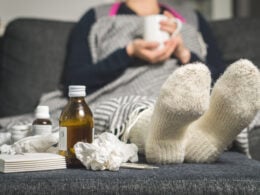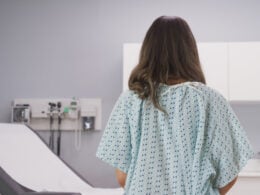I always thought that excruciating pain was just the price I had to pay for being a woman.
I didn’t think it was normal, per se, but I didn’t think it was something to worry about. My gynecologist prescribed the birth control pill and didn’t seem too concerned, so I wasn’t concerned, either.
Fast-forward one decade, and I had stopped taking the Pill for health and faith-based reasons. At first, my period, while irregular, wasn’t very painful. I must have grown out of the really bad pain, I thought.
My gynecologist, who is trained in Natural Procreative Technology (also known as NaProTechnology, or simply “NaPro”) suspected that I might have endometriosis, but I was sure she was wrong. I’d always heard that endometriosis was debilitating, and I just wasn’t doing that badly.
But with each period post-Pill, my pain was worse, and soon, I was experiencing it around ovulation, too. My hips were constantly sore; I couldn’t even kneel at church without pain.
Laparoscopic surgery confirmed it: I had endometriosis. My doctor removed it all in the surgery, but this summer, my symptoms came back. I don’t know for sure if it’s the endometriosis, but whether it is or not, I am now charting more accurately and thoroughly than I was before my surgery. And, while charting is certainly not a painkiller, it has helped me understand and manage my pain more effectively. Here’s how.
What is endometriosis?
First of all, let’s clarify some terms.
Endometriosis is an inflammatory disorder in which tissue similar to the endometrium (the tissue lining the inside of the uterus) grows outside of the uterus, typically on other organs in your pelvic region, like the ovaries and fallopian tubes, and even the bladder and bowel. This tissue acts like the endometrium, breaking down and bleeding during menstruation, but it can’t leave the body through the vagina, so it stays in the body and forms scar tissue, adhesions, and bands of tissue between organs.
There are several theories as to the cause of endometriosis, but so far none have been definitively proven. Determining the source of the disease is further complicated by the fact that it can only be diagnosed with certainty by laparoscopy, and some doctors still do not recognize it when it is present. A common treatment for endometriosis, whether or not it’s formally diagnosed, is the birth control pill, which prevents the bleeding—but does not treat the endometriosis. In fact, the use of oral contraception can make endometriosis worse, which helps explain why mine was so bad after 10 years on the Pill. Unfortunately, there has been little recent research on endometriosis, aside from the use of synthetic hormones for treatment.
NaPro gynecologists typically recommend diet, exercise, nutrition supplements, and/or surgery to treat endometriosis. For instance, I am on an anti-inflammatory diet (no gluten, dairy, or processed sugar) to help control my PCOS and endometriosis, both of which are exacerbated by inflammation. Therapy and meditation can also help with pain management.
How charting your cycles can help you manage endometriosis pain
Fertility awareness methods (FAM)—methods of tracking reproductive health and related symptoms to understand health and fertility—can help manage cycle pain in two ways: by helping you understand when pain happens and, relatedly, by helping you understand why pain happens.
Whenever you experience pelvic pain, lower back pain, and/or cramping at any point in your cycle, write down when it happens during your cycle. This is the basic premise of fertility charting—monitoring your body’s signs and symptoms. Chart where the pain is, what it feels like, and how bad it is. Chart whether taking a pain medication helps and which pain medication helps. Chart whether you were able to go about your day or whether you were bed-ridden (or anything in between). Chart any painful urination, bowel movements, or sex. Chart any other symptoms that are out of the ordinary or that you associate with your endometriosis. As with anything in charting, err on the side of too much information. (It is highly recommended to learn how to chart your cycle with an evidence-based fertility awareness method from a certified instructor, and if you’re concerned about a medical condition like endometriosis, you could consider some of the medically compatible methods such as Creighton or FEMM.)
When you have tracked a few cycles of data, look back to see if you can identify any patterns in your symptoms. Did your pain always happen in the days leading up to your period? What about during your period? What about before, during, or after ovulation?
Knowing when your pain happens helps you understand why it happens, which helps you prepare for it, especially if you are charting other biomarkers. If you know you tend to have pain around ovulation, for instance, you can start taking ibuprofen, partaking in lower-intensity exercise, and resting more when you start observing signs that ovulation is approaching. Identifying the triggers of your pain also helps you cut yourself some slack: Ovulation is particularly hard on your body. You aren’t being a wimp if you’re hurting; you’re feeling the effects of releasing an egg in a somewhat hostile environment.
There’s no way around it: Endometriosis is hard. And, until the researchers catch up and find better diagnostics and treatments for women, it’s going to continue to be hard. Fortunately, there are ways to predict it and, therefore, manage it a little. When it comes to gynecologic health, I have found that more information really is power.
Find a doctor trained in restorative reproductive medicine.
Additional Reading:
“What causes endometriosis?” and other questions: A Natural Womanhood Endo FAQ
What to Do When Your Doctor Won’t Listen to You
Supplements for PMS Symptoms that Really Work
“Why do I get pre-period bloat?” and other PMS questions, answered: A Natural Womanhood PMS FAQ
3 Simple Nutrition Tips that Will Improve Your Reproductive Health
How Whole30 Helped Me Manage my PCOS and Overcome Infertility











